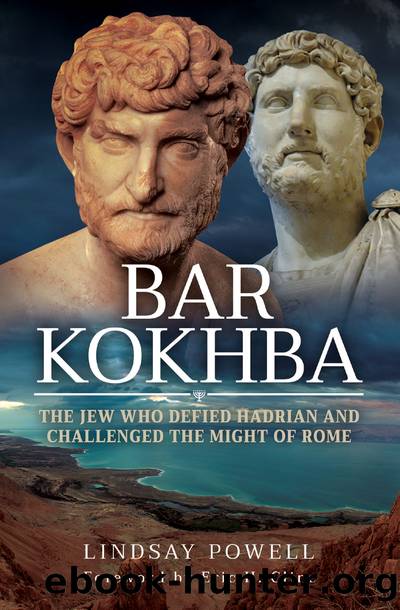Bar Kokhba by Lindsay Powell;

Author:Lindsay Powell;
Language: eng
Format: epub
Tags: HISTORY / Military / Ancient
Publisher: Casemate Publishers & Book Distributors, LLC
Published: 2020-04-02T00:00:00+00:00
At the western end of the canyon in the âCave of Horrorsâ, which was smaller than the âCave of Lettersâ, conditions were cramped and unsanitary.41 The occupants had brought their possessions with them too, both luxury and utilitarian: combs, fish nets, gaming pieces, glass bowls and jugs, nails, needles, tooled leather, wooden boxes and cash.42 They hid the Greek and Hebrew documents as best they could, but there was no space to bury the larger items. Instead, they lit a fire in the centre of the cave, broke up the glassware and utensils, and threw their treasures onto the pyre. Was it an act of despair or of defiance?
The Roman army, meantime, had set up two camps, one on either side of the Nahal Hever canyon. One stood on the ledge above the âCave of Lettersâ (which archaeologists call âCamp Aâ) on the north side, the other above the âSquare Caveâ or âCave of Horrorsâ (âCamp Bâ) on the south side.43 Soldiers in each encampment could watch activity in the cave on the opposite side of the canyon and relay messages to their colleagues; they could harass the people trapped in the cave directly below and prevent their escape; additionally, âCamp Bâ also controlled access to the only available source of water.44 Enough survives of âCamp Aâ for us to understand its design and function. Using field stones, the troops set up a {-shaped perimeter wall with a clavicular gate at its centre. The enclosed space was around 1,250 square metres (13,455 sq ft). Inside the secure compound there was a principia, comprising three rooms from which the camp commandant and his staff could direct operations. There were hearths or ovens for baking bread. There was a walled-off space, presumably for supplies. The soldiers set up their contubernium tents and arranged stones around them forming low-walled âcubiclesâ, either to anchor the tent pegs in the dry ground or to protect the occupants from the chill desert wind. The goatskin tents, perhaps ten in number, were arranged back-to-back in two irregular-shaped clusters. It is likely that a centuria of eighty men was barracked at âCamp Aâ, perhaps from Cohors I Thracum Milliaria, which is known to have had a presence at Ein Gedi in 124 CE.45 The impression they give is one of semipermanence. This was not a temporary overnight camp; it was designed with weeks or even months of occupation in mind. The Romans would be here for as long as it took to eliminate the last of the insurgents. Time was now on their side.
As at Betar, the Romans let thirst and starvation to do their dirty work. There would be no escape for the fugitives. A dramatic tale is told in Midrash:
Figure 32. A view looking out from the âCave of Lettersâ to the Dead Sea. Archaeologists found the personal possessions and household items that the refugees had taken with them. They included letters and contracts, many of which have been preserved in the dry desert conditions.
Download
This site does not store any files on its server. We only index and link to content provided by other sites. Please contact the content providers to delete copyright contents if any and email us, we'll remove relevant links or contents immediately.
| France | Germany |
| Great Britain | Greece |
| Italy | Rome |
| Russia | Spain & Portugal |
Fanny Burney by Claire Harman(26530)
Empire of the Sikhs by Patwant Singh(22980)
Out of India by Michael Foss(16792)
Leonardo da Vinci by Walter Isaacson(13189)
Small Great Things by Jodi Picoult(7024)
The Six Wives Of Henry VIII (WOMEN IN HISTORY) by Fraser Antonia(5400)
The Wind in My Hair by Masih Alinejad(5034)
A Higher Loyalty: Truth, Lies, and Leadership by James Comey(4851)
The Lonely City by Olivia Laing(4751)
The Crown by Robert Lacey(4731)
Millionaire: The Philanderer, Gambler, and Duelist Who Invented Modern Finance by Janet Gleeson(4386)
The Iron Duke by The Iron Duke(4294)
Papillon (English) by Henri Charrière(4199)
Sticky Fingers by Joe Hagan(4106)
Joan of Arc by Mary Gordon(4022)
Alive: The Story of the Andes Survivors by Piers Paul Read(3970)
Stalin by Stephen Kotkin(3883)
Aleister Crowley: The Biography by Tobias Churton(3589)
Ants Among Elephants by Sujatha Gidla(3417)
